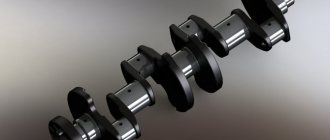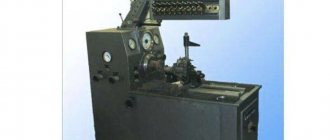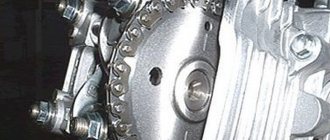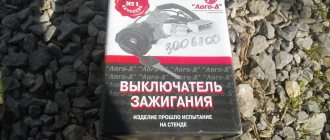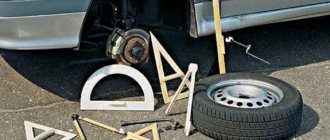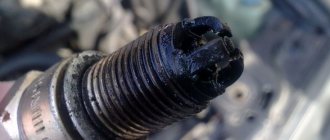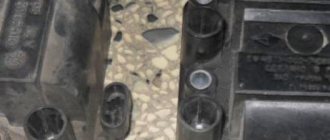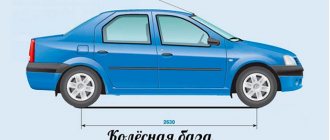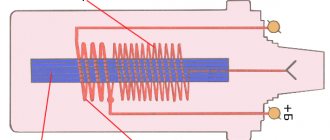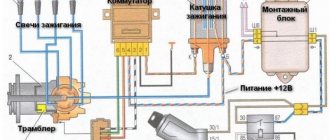What is ignition timing - also known as ignition timing? Is this some kind of attribute of ancient cars or something unshakable, akin to universal gravity? Most modern car owners are unaware of this. All car systems are controlled by numerous controllers, and therefore timely sparking in the engine cylinders is entirely their responsibility. Meanwhile, a huge number of ancient machines are running around the country, unfamiliar with processors and other chips. Therefore, questions like “How to regulate the SOP?” still sound today.
It's always a pleasure to answer technical questions. But first you have to remember some “incendiary” terms.
Terminology
Ignition distributor
- an electromechanical device that ensures timely supply of high voltage pulses to the spark plugs.
It is often called a distributor
.
Contact and non-contact distributors for rear- and all-wheel drive carburetor VAZ cars
Contact and non-contact distributors for rear- and all-wheel drive carburetor VAZ cars
Ignition advance
- ignition of the working mixture in the cylinder before the compression stroke ends.
Ignition timing (IDA)
— the angle of rotation of the engine crankshaft from the position corresponding to the appearance of a spark on the spark plug until the piston reaches top dead center.
Setting the ignition angle during chip tuning
At factories, the OZ is set up with low-quality fuel in mind, usually leaving a margin of a couple of degrees. This allows you to ensure a guaranteed engine life even when using poor quality fuel. But with such fuel, power and torque are reduced. During normal driving, the owner may not notice that there is something wrong with the car, but with active pedaling the problem will manifest itself.
Visualization of the basic OZ map in the ChipTuningPRO program.
During chip tuning, the calibrator adjusts the OZ using the reserves left by the manufacturer. After chipping, fuel requirements will increase: you will need to fill in good AI-95 or AI-98. On the plus side, the car will become more dynamic and responsive.
Read more about the possibilities of chip tuning in the site material.
You can adjust the ignition timing and do chip tuning from our representatives. The closest ones can be found on the map below.
When and why do you need to adjust the ignition?
First, a little theory. If the working mixture in the cylinders burned instantly, then there would be no problems with advance in principle. Set it on fire at top dead center and everything is fine. But the mixture does not burn instantly: it takes milliseconds. In this case, the actual rotation speed of the crankshaft is, of course, not constant. Therefore, you cannot stupidly ignite the mixture at the same time under different engine operating modes: it will burn either too early or too late. The result will always be disappointing - the engine pulls poorly, overheats, runs unstably, detonates, etc.
Ignition timing on engines with electronic injection
The operation of modern gasoline and diesel engines with electronic injection is controlled using firmware that is embedded in the ECU. The entire system is based on the interaction of a controller, electronic sensors and actuators. For this reason, the ignition is not installed on such cars.
For normal operation of the fuel supply and ignition systems, the ECU receives a signal from the sensors, after which the received information is processed and compared with special fuel maps that are located in the firmware of the control unit. The main signals come from the crankshaft and camshaft sensors. Taking into account the position of the crankshaft and camshaft, the ECU calculates the moment of fuel injection by an injection nozzle, as well as the moment of ignition of the fuel-air mixture (only for gasoline internal combustion engines) in the cylinder, adjusted for speed and engine load.
Electronic ignition control means that changing the ignition angle (fuel injection advance angle for a diesel engine) and fuel maps on such systems can only be done using a computer to which the ECU is connected. This is done if software chip tuning of the internal combustion engine is necessary, as well as after making various changes to the engine design.
On standard cars, malfunctions in the electronic ignition can occur due to electronic malfunctions, which are diagnosed in real time by analyzing signals from sensors. After identifying a faulty sensor or wiring problems, the cause is eliminated or the electronic device is replaced with a known good one.
Additionally, you should pay attention to ensure that all marks on the flywheel and timing pulleys match exactly. In a diesel engine, it is also necessary to separately check the condition of the injection pump drive. Incorrectly set marks will lead to erroneous signals being sent to the ECU, resulting in ignition failures and disruption of the synchronization of the operation of devices and mechanisms.
How to counteract?
First, follow the manufacturer's recommendations for the minimum octane number of gasoline used. If the manufacturer recommends 98 octane fuel, be sure to use it. The apparent savings will quickly be offset by the need for a major overhaul immediately after the first few series of pre-ignition. You only need to refuel at certain stations. Using gasoline of unknown origin increases the risk that the fuel does not maintain the intended octane rating.
Another issue is regular oil changes, at intervals of 10-15 thousand kilometers. Oil producers have already adapted products in an attempt to counteract the LSPI phenomenon. There are oils on the market that promise to counteract the phenomenon of premature combustion within specifications. In laboratory tests, it was found that removing calcium particles from the oil contributes to this. Substitution with other chemicals has reduced the risk of this problem. Therefore, if the engine is of low power, anti-LSPI oil is used, while respecting the SAE and API specifications specified by the vehicle manufacturer.
Where is the VROZ located and what is the danger of its failure?
VROZ is installed on the distributor. The latter consists of a body with a lid made of fabric. The two elements are separated by a special diaphragm. VROZ includes springs and other components.
How to check ignition timing
A malfunctioning regulator can easily result from problematic engine operation. There will be no ignition adjustment.
It is enough to look at how the crank shaft rotates after insulating the hose with VROZ to understand the importance of the operation of the regulator.
The cause of VROZ failure may be jamming of bearings or loosening of fasteners. The tightness of the VROZ is a very important thing, and it can easily be damaged if the tube leaks air somewhere. Also, the loss of tightness will be affected by low tightness of the fitting, critical damage to the diaphragm and much more.
You can clearly see what happens to the engine when the VROZ is damaged or loses its tightness in the table below.
Article on the topic: Replacing the wheel bearing
| Causes of malfunction | Remedies |
| Insufficient gap between breaker contacts | It will be enough to adjust the gap |
| Contamination of the distributor slider and cover, the appearance of cracks in them, leading to greater leakage of high voltage current, burning of the sockets in the cover | Wipe the slider and lid. If there are cracks or burnt sockets, the faulty slider or cover must be replaced |
| Burning breaker contacts | Clear contacts |
| Excessive wear of the roller bushings, uneven wear of the distributor cam, severe wear of the moving contact axis | Disassemble the distributor, replace worn parts, assemble and adjust the distributor |
| The engine does not develop full power | |
| Breaker lever spring weakening | Check the pressing force of the breaker contacts and, if it is lower than required, replace the spring |
| Ignition installed incorrectly | Check that the ignition is installed correctly |
| The centrifugal ignition timing regulator is faulty | Disassemble the distributor and fix the problem |
| The vacuum ignition timing regulator is faulty | Check the condition of the vacuum regulator tube and, if damaged, replace the tube. If there is no damage, check the vacuum regulator on the stand and replace if necessary. |
Self-configuration of UOZ
How to ignite early? This work involves regulation of POP. It should run at idle
It is important here to maintain the correct speed in the intervals of 850 - 90 rpm
Ignition timing slope values can be positive or negative. In the first case they reach +1 degree. In the second, they start from -1 degree. The indicated degree is the degree of interaction with TDC.
Signs of early and late ignition: in many cases, this moment is established using a strobe light. This device helps achieve meticulous tuning. If this device is not available, you can work with a control lamp. It is connected to ground and the positive terminal on the ignition distributor.
The following are the most popular methods that can be used to properly tune the ignition. The basis is taken from classic domestically produced equipment.
Changing the OZ on a gasoline engine
You need to start work by preparing the tool. We will need a wrench and a test light. You can't do without a special wrench that can be used to turn the crankshaft. After all, in fact, its position determines the value of the OZ. You can also purchase a special ignition timing corrector, which can set this characteristic automatically.
Place the car in neutral and apply the parking brake. Then you need to remove the cover from the breaker. This way you can easily get to the crankshaft, which is turned with a special wrench until the distributor runner is in the sector of the first cylinder of the distributor. Also, be sure to follow the positions of the marks on the ebb of the front cover and the pulley; they must match.
Removing the cover from the breaker
Now, to correctly set the ignition timing, you need to connect the control lamp. One of its terminals is connected to the ignition coil, and the second to the engine ground. Slightly loosen the distributor fastening and turn the key in the ignition. We clamp the slider against the stroke and turn the distributor in the opposite direction of movement of its roller until the control lamp goes out. To be safe, turn the distributor a little more and very carefully return it in the opposite direction. It is necessary to record the moment of ignition of the lighting device. In this position, you need to align and secure the body of the breaker-distributor with bolts. All that remains is to return the lid to its place.
To automate the ignition timing adjustment as much as possible, a vacuum regulator is introduced. Such a device automatically changes the SOP depending on the load. If the engine is idling, then the vacuum regulator turns the chopper disc towards late ignition. As soon as the load increases, a vacuum occurs. Then the vacuum regulator rotates the breaker disk in the opposite direction. So it seems to turn off, because it cannot create a leading angle. At this moment the centrifugal regulator comes into play. Now only he sets the advance angle.
Vacuum regulator UOZ
The fact of vacuum allows you to record the sensitive diaphragm with which the vacuum regulator is equipped. On the one hand, it is affected by our atmosphere, and on the other, by pressure from the carburetor. So it turns out that when the throttle valve is closed, rarefied air from the system does not reach this diaphragm and the vacuum regulator fulfills its mission. As soon as the rarefied atmosphere hits it, it bends and the device stops working, returning everything to its place.
A little earlier, a little later
By turning the distributor clockwise (to the right), the base ignition angle decreases and is delayed, the ignition tends to TDC (14-12-10... degrees.). This is a later ignition, it must be set if the mixture is lean.
By turning the distributor counterclockwise (to the left) - the base ignition angle decreases and advances, the ignition tends from TDC (10-12-14... degrees.) This is an earlier ignition, it must be set if the mixture is rich.
Higher octane fuel needs earlier ignition because high octane fuel burns longer.
Jet Sensor. Only petrol. Only powered by battery. And only 3 wires! The simplest and most affordable strobe.
APPLICATION WITH CONTACT IGNITION SYSTEM
If the car has a contact ignition system (breaker and coil B117A), the ignition unit is assembled according to the diagram in Fig. 3.
Rice. 3. Device diagram for a contact ignition system.
A breaker is used as a TDC sensor, a homemade inductive vacuum sensor (this option is described in detail in the Radio magazine, No. 11, 2008, p. 36), but DBP 45.3829 can also be used (for connection, see Fig. 4a, Fig. 4b).
How to determine early or late ignition
As stated earlier, incorrect ignition angle has certain symptoms. Actually, from them you can find out whether it is early. In normal operation of an internal combustion engine, the fuel ignites at the end of the compression stroke, that is, immediately before reaching TDC. When the explosion reaches maximum energy, the piston will begin to move downwards, which will lead to additional acceleration of the crankshaft. If the ignition is earlier or later, then the engine will in any case not gain its power, but with a late spark the dynamics are more pronounced, but there is a risk of overheating of the exhaust manifold, accompanied by explosions inside it.
On gasoline
If late ignition of the mixture occurs, then strong heating of the internal combustion engine and especially the exhaust manifold occurs, accompanied by explosions. When you press the gas pedal at a speed of about 40-50 km/h, there is no detonation characteristic of normal operation.
On diesel
On cars with a diesel power unit, there is no such thing as late or early ignition, because they do not have a spark. Ignition of the mixture occurs at the moment of its compression, that is, synchronous. In earlier modifications, this could still be somehow adjusted manually. This function is not implemented in modern cars.
On a car with HBO
Many owners install gas equipment on their cars because gas remains cheaper than gasoline. If it is present, it is also very important to correctly adjust the ignition angle of the combustible substance. Unlike liquid hydrocarbons, propane has a higher octane number (100-105, methane 120 octane). For this reason, angle adjustment is mandatory, since with a normal gasoline setting, the economic effect will be very small. For this purpose, HBO kits include a special unit called a variator. It switches the angle according to the mixture selection. For the most optimal operation, an increased advance angle is required, since gas burns longer than gasoline. They also resort to changing the compression ratio by lengthening the connecting rods, but such a motor will no longer be able to operate normally on liquid fuel. Accordingly, late ignition is dangerous for a gas internal combustion engine. If you install the HBO on classic, then you need to turn the distributor to “+” by 3-8 degrees.
Signs of a downed UZ
The process of ignition of the mixture of fuel and air in the engine chambers (late or advanced) can lead to various malfunctions in the engine. The following signs will help you determine that the ignition timing is set incorrectly:
- There are difficulties starting the engine.
- The car's appetite increases noticeably.
- The engine loses throttle response and engine power decreases.
- You can observe unstable operation at idle.
- When you press the gas, the responsiveness of the unit is lost, overheating is observed, as well as detonation.
- You may also hear popping sounds - in the carburetor or intake manifold or in the exhaust system.
Basic elements of SZ
The main components of such a SZ:
- Filter element.
- Additional resistor SZ.
- Capacitor filter.
- A starter unit used to generate a high-voltage pulse.
- Emergency vibrating device.
- A distribution device, popularly called a “distributor”.
- Spark plugs, one for each cylinder.
- Coil.
- Transistor switching unit.
- Ignition switch or lock KAMAZ Euro 3.
Features of the ignition switch
In order to properly adjust and configure the system’s performance on a Euro 3 KAMAZ, we recommend that you familiarize yourself with the main features of the lock’s operation. This unit is a switching device used to turn on and off the power unit, as well as the entire on-board network of the vehicle.
In KAMAZ Euro 3 or 2 vehicles, this mechanism performs the following functions:
- With its help, the machine’s bot network is activated and disconnected to the battery, as well as to the generator unit. Moreover, the network is disconnected from the battery after starting the power unit, since after this the power supply is supplied from the generator.
- Also, thanks to the lock, the SZ itself is activated and deactivated, in particular, its primary low-current motor circuit to the voltage source.
- The lock also briefly activates the starter assembly when you turn the key and try to start the power unit.
- As you know, the lock itself has several operating positions. In the initial position, all devices and systems are turned off, the on-board network is de-energized. By turning the key to position I, you can turn on the car's audio system, optics and some other mechanisms connected to the ignition when the power unit is turned off. The end position is used directly to start the engine.
- The lock can also serve as an anti-theft option, activating the steering wheel locking mechanism when the engine is turned off (the author of the video is the ICE Theory channel).
PS Experience with D16Z6
My most hellish experience is of course my car, by accident or on purpose I tested the mechanics and electrics on it. The car is surprisingly durable, which I'm glad about. In general, when I installed the VTEC cylinder head D16Z6, I found out that a special TD-42U ignition distributor goes to the cylinder head. TD42U differs from its brothers which became universal and were installed on most engines, I'm talking about TD-80U, TD-72U, etc. The difference between the TD-42U and others is that the mounting legs, there are 3 of them, are not located at 120 degrees, but have a slightly asymmetrical arrangement. Therefore, only one distributor fits the D16Z6 cylinder head. Mine was in very poor condition, rotten and torn wires, and based on my not yet rich experience, I decided that the distributors were the same and only the back plate needed to be changed.
D15B7 TD-41u (TD-80u) and D16Z6 TD-42U, difference in mounts
Why did I decide that they are the same? Judge for yourself: the coil, switch, slider, and covers are the same. Perhaps TD-42U, TD-41U, TD-40U are one distributor with a different revision and the difference is in the leg mounting plate. Installing another one is problematic and not feng shui. But that was also my mistake.
Both distributors look identical
TD-42U body with TD-41U interior
Very quickly I found the TD-41U distributor from D15B7. I opened both, re-soldered the wires on the sensors, installed them... But I didn’t install the OZ. Of course the car started, I achieved results in the firmware. but they were not impressive, there were no lows at all. And then I remembered my fraud with the distributor.
And then it dawned on me that my OZ is neither 12 nor 14... but within 20-25 degrees. Having tightened the distributor all the way, I set it to about 16. The distributor did not turn further. In the firmware, I simply systematically added the missing 4 degrees, and the car started playing in a new way.
The problem physically remains. The distributor axis where the slider is put on has a different angle. Therefore, this difference had a negative impact on performance. Therefore, if you are going to collect one from several, be careful. Set the ignition to a strobe light, save on fuel and start in winter the first time!
How useful is the publication?
Click on a star to rate!
Average rating 5 / 5. Number of ratings: 4
No ratings yet. Be the first to rate.
Total:
It is absolutely necessary to set the OZ, do not listen to anyone who says “The OZ is set by itself thanks to the computer.” Yes, this is partly true. But the computer either subtracts or adds angles. When draining, you need 12 degrees, this is the standard angle on Honda D series engines. If you know the matter, the angle can be set for different fuels, this especially helps with bad fuel. Incorrectly set OZ is a common cause of poor starting, high fuel consumption and, of course, loss of power. In rare cases, as a catalyst for reducing engine life. The OZ must be set after overhauling the engine or during any work with the distributor. Exposing it by ear is not fashionable. If you start tuning an engine and find firmware that matches your spec, be sure to find out the base angle at which the ignition map was built.
Practice setting the ignition of the Honda Civic
To set the ignition correctly, you need to have a strobe light. The price is approximately $20. Essentially, this is a flashlight that shows exactly when the ignition occurred. A 3-wire strobe is required. One wire goes to + battery, the other to – battery. The third wire is usually a clothespin or “hook” with a sensor that clings to the first (right) high-voltage ignition wire. Attention! You need a strobe powered from a battery and for gasoline engines, and in no case from an ignition coil. Proven models for Russia are “Jet-sensor” and “Orion ST-01”.
First, you must loosen the bolts on the ignition distributor with a 12mm wrench so that it can be rotated in both directions, but so that the distributor does not move away from the cylinder head. The car should be warmed up and the idle should be leveled to 750-800 RPM. Turn off the ignition. Connect + and – of the strobe light to the battery. and “put the clothespin-sensor” on the base of the high-voltage wire of the first (right) cylinder) closer to the spark plug. turn on the service mode for reading errors. It is also recommended to find 3 consecutive marks on the crankshaft pulley, clean them and mark the middle one with white paint or paper putty or corrector. Turn on the ignition and start the engine, the Check Engine light will come on. The engine must be unloaded as much as possible. Turn on neutral, turn off the air conditioning, music, lights.
If you did everything correctly, you will see a flashing strobe light. Direct it through the “target” onto the crankshaft pulley. The white mark should be clearly visible under the flashes. Your task is to align the target and the central mark (12 degrees). Turning the ignition distributor (with the engine running) corresponds to turning on the crankshaft; if the mark needs to be “moved” to the right, turn the ignition distributor to the right. When the OZ mark is set, tighten the ignition distributor bolts, turn off the strobe light and turn off the CheckEngine service mode.
Why does it crash?
Failure of the OZ is a common problem. The parameters that have already been set are often not suitable for the conditions in which the machine is operated. Specific conditions require a specific angle. It can be set manually.
But before issuing a SOP, it is worth making sure that the interventions are really needed. It is better to conduct a hearing test yourself. For example, accelerate the car to 40 km/h and brake sharply in fourth gear.
Detonation sounds with normal acceleration indicate that there is no need to interfere with the work and change the angle. If the sound remains, the car does not accelerate, which means the ignition has failed. If the detonation still does not disappear, then the OZ is early, and the ignition is late.
You can set the advance angle yourself using a strobe device. For contactless ignition, you can set it up by ear and check the operation using the method described above.
